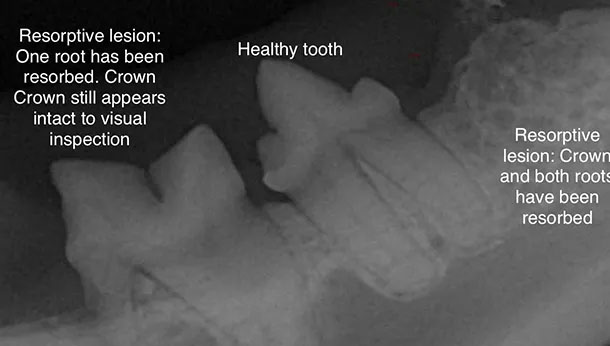As a dedicated cat owner, ensuring your feline friend's health and well-being is a top priority. At Valley Veterinary Services, we understand the unique challenges and joys of caring for cats. One common yet often overlooked dental disease that affects many cats is feline odontoclastic resorptive lesions (FORLs). In this blog, we’ll delve into what FORLs are, how to identify them, and the importance of timely veterinary care.
What Are Feline Odontoclastic Resorptive Lesions?
Feline odontoclastic resorptive lesions, or feline oral resorptive lesions, is a progressive condition where the dentin (a hard tissue beneath the enamel) erodes and is irreversibly destroyed. Over time, this process can involve all areas of the affected tooth.

What Causes Tooth Resorption?
The exact cause of tooth resorption in cats is not well understood. What we do know is that the resorption is caused by odontoclasts-cells that are responsible for normal remodeling of tooth structure. These cells are activated, but then do not down-regulate, ultimately resulting in tooth destruction. The odontoclastic resorption generally begins on the root surface, destroying the cementum first and then the dentin. What is unknown at this point is what activates the odontoclasts.
Types of Tooth Resorption
Tooth resorption in cats is categorized into types based on the dental x-ray (radiographic) appearance of the root:
- Type 1 Tooth Resorption: Characterized by the destruction of the tooth crown while the root retains a normal appearance with an easily visible periodontal ligament.
- Type 2 Tooth Resorption: The root appears to be disintegrating and is not distinct from the bone, referred to as replacement resorption.
- Type 3 Tooth Resorption: Exhibits features of both Type 1 and Type 2.
Type 1 tooth resorption is often linked to periodontal disease, and regardless of the type, the result is the loss of the outer hard tissues of the tooth, which can be very painful.
Signs and Symptoms
Cats are masters at hiding discomfort, making early detection of FORLs challenging. However, some signs to watch for include:
- Difficulty Eating: Your cat may chew on one side of the mouth or drop food while eating.
- Drooling: Excessive drooling, often tinged with blood.
- Bad Breath: Persistent bad breath can be an indicator of dental issues.
- Behavioural Changes: Irritability or aggression, especially when the mouth area is touched.
- Visible Lesions: If you’re able to look inside your cat’s mouth, you might see red, inflamed areas around the gum line or visible holes in the teeth.
Diagnosis and Treatment
At Valley Veterinary Services, our team of experienced veterinarians employs advanced diagnostic tools to identify and treat FORLs effectively. During a comprehensive oral health assessment, we will recommend full mouth dental radiographs (X-rays) to assess the extent of the lesion and plan the best course of action.
Treatment options typically involve:
- Type 1 Tooth Resorption: Both the crown and root need to be extracted.
- Type 2 Tooth Resorption: Crown amputation with intentional root retention may be appropriate.
Regardless of the type, pain management and regular dental check-ups are crucial to ensure your cat's comfort and long-term health.
Preventive Care
Preventive dental care is essential in managing your cat's oral health. Here are some tips:
- Routine Vet Visits: Schedule regular check-ups with our veterinary team to monitor your cat's dental health.
- At-Home Dental Care: Brush your cat’s teeth regularly with feline-friendly toothbrush and toothpaste.
- Diet: Provide a balanced diet that includes dental-friendly cat food to help reduce plaque and tartar build-up.
Why Choose Valley Veterinary Services?
At Valley Veterinary Services, we are committed to providing the highest standard of care for your pets. Our state-of-the-art facility, compassionate staff, and personalized approach ensure that your feline companion receives the best possible care. We understand that every cat is unique, and we tailor our treatments to meet their specific needs.
Schedule Your Cat’s Dental Check-Up Today!
If you notice any signs of dental discomfort in your cat or it's time for a routine check-up, don't hesitate to contact us. Schedule an appointment at Valley Veterinary Services and take the first step towards ensuring your cat's dental health and overall well-being.
Written by Dr. Yuri Yoon